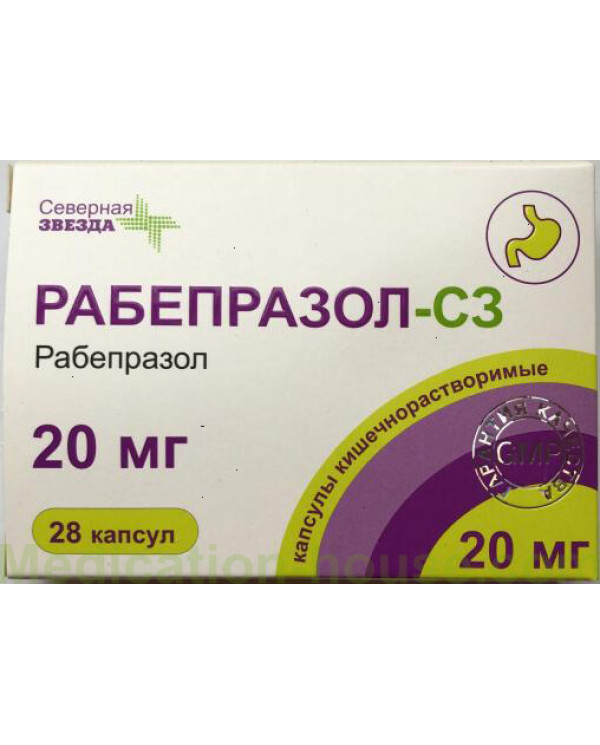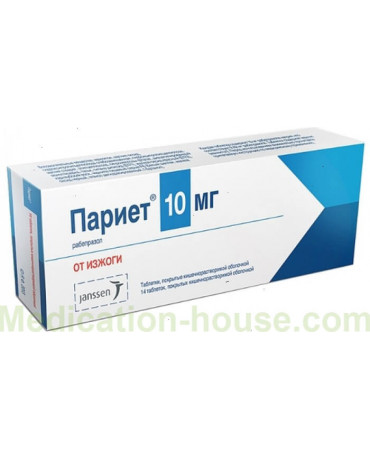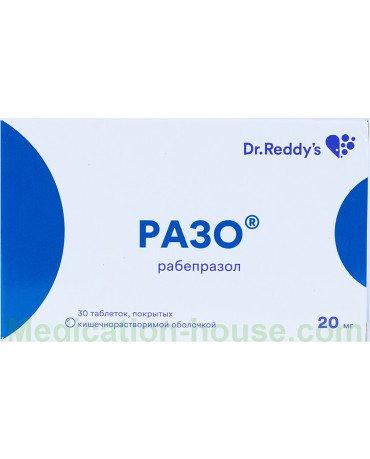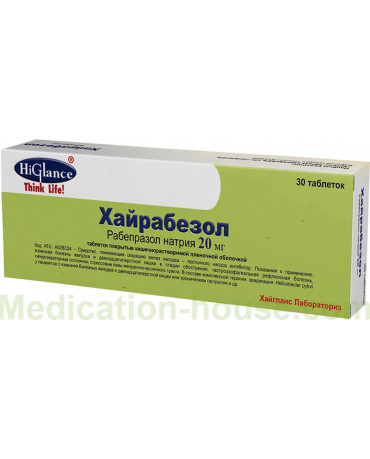Release form and composition
Dosage form - enteric capsules: hard gelatin; dosage of 10 mg - size No. 3, body color white, caps - dark red; dosage of 20 mg - size No. 1, body color yellow, caps - brown; capsule contents - spherical pellets from white with a yellowish or creamy tint to almost white (in a cardboard pack of 2, 3 or 6 blisters for 10 tablets, or 1, 2 or 4 blisters for 14 tablets, or 1 plastic can or bottle 30, 60 or 100 tablets and instructions for use of Rabeprazole).
The composition of the pellets (1 capsule of 10/20 mg, respectively):
active substance: rabeprazole sodium - 10/20 mg (rabeprazole pellets - 118/236 mg, respectively);
excipients: hydroxymethyl cellulose - 14.75 / 29.5 mg; sodium carbonate - 1.65 / 3.3 mg; sugar grains (starch syrup, sucrose) - 71.47 / 142.94 mg; talc - 1.77 / 3.54 mg; titanium dioxide - 0.83 / 1.66 mg;
shell: cetyl alcohol - 1.6 / 3.2 mg; hypromellose phthalate - 15.93 / 31.86 mg.
Capsule composition (10/20 mg, respectively):
case: iron oxide yellow - 0 / 0.192%; titanium dioxide - 2/1%; gelatin - up to 100 / up to 100%;
cap: dye azorubine - 0.661 9/0%; indigo carmine - 0.028 6/0%; titanium dioxide - 0.666 6 / 0.333 3%; black iron oxide - 0 / 0.53%; iron oxide yellow - 0 / 0.2%; iron oxide red - 0 / 0.93%; gelatin - up to 100 / up to 100%.
Pharmacodynamics
The drug - the active substance of Rabeprazole, is one of benzimidazole derivatives, antisecretory substances. The main effects of the drug:
suppression of secretion of gastric juice: provided by specific inhibition of H + / K + -ATPase on the secretory surface of parietal cells of the stomach;
blocking the final stage of hydrochloric acid secretion: the content of stimulated and basal secretion is reduced regardless of the etiology of the stimulus.
Due to its high lipophilicity, The drug easily penetrates into the parietal cells of the stomach, where its concentration occurs, as a result, the drug increases the secretion of bicarbonate and has a cytoprotective effect.
After oral administration of The drug at a dose of 20 mg, the antisecretory effect develops within one hour, the maximum effect in 2-4 hours. 23 hours after taking the first dose of The drug, inhibition of basal acid secretion is 62%, and food-stimulated 82%. This effect is maintained for approximately 48 hours. In case of discontinuation of therapy, secretory activity is restored in 1-2 days.
The plasma concentration of gastrin in the blood increases during the first 2–8 weeks of treatment (which reflects the inhibitory effect on the secretion of hydrochloric acid). 7-14 days after discontinuation of the drug, the value of this indicator returns to its original level.
The drug does not have anticholinergic properties; it does not affect the central nervous, respiratory and cardiovascular systems.
In rabeprazole therapy, the development of persistent changes in the severity of gastritis, in the morphological structure of enterochromaffin-like cells, in the frequency of atrophic gastritis, intestinal metaplasia, or the spread of Helicobacter pylori infection has not been detected.
Pharmacokinetics
The substance is rapidly absorbed from the intestine, after taking 20 mg of rabeprazole Cmax (maximum concentration of the substance) in plasma is reached in about 3.5 hours. The change in Cmax values in plasma and AUC (the area under the concentration-time curve) is linear when Rabeprazole is used in a dose range of 10–40 mg. The absolute bioavailability after oral administration of 20 mg of the substance (compared with intravenous administration) is approximately 52%. With repeated administration of rabeprazole, the value of this indicator does not change.
The time of day and the simultaneous administration of antacids do not affect the degree of absorption of The drug. When taking the drug with fatty foods, the absorption of The drug slows down for 4 hours or more, however, the values of Cmax and the degree of absorption remain unchanged.
The degree of binding of The drug to plasma proteins in humans is approximately 97%.
T1 / 2 (half-life) from plasma in healthy volunteers is in the range from 0.7 to 1.5 hours (an average of 1 hour), the total clearance is 3.8 ml / min / kg.
After a single oral administration of 20 mg of 14C-labeled rabeprazole in the urine, an unchanged substance was not found. Excretion of approximately 90% of The drug occurs in the urine mainly in the form of two metabolites: a carboxylic acid and a mercapturic acid conjugate (M6 and M5, respectively). Two unknown metabolites that were identified by toxicological analysis are also excreted. The rest of the substance is excreted in the feces.
A total of 99.8% of The drug is excreted. This indicates a slight excretion of metabolites with bile. The main metabolite (M1) is the thioether. The only metabolite exhibiting activity is desmethyl (M3), but it was observed in only one study participant at a low concentration after taking 80 mg of rabeprazole.
With stable renal failure in the terminal stage in patients who need maintenance hemodialysis (with creatinine clearance <5 ml / min / 1.73 m2), excretion of the substance is similar to that in healthy volunteers. The values of Cmax and AUC in these patients were approximately 35% lower than in healthy volunteers. Average T1 / 2: healthy volunteers - 0.82 hours, patients during hemodialysis - 0.95 hours, patients after hemodialysis - 3.6 hours. The clearance of rabeprazole in patients with kidney diseases who need hemodialysis is about 2 times higher than in healthy volunteers.
The AUC value in patients with chronic liver damage is 2 times higher than in healthy volunteers, which indicates a decrease in the effect of the first passage through the liver, and T1 / 2 from plasma is 2-3 times higher. Despite the fact that in patients with chronic compensated liver cirrhosis, AUC is 2 times higher, and Cmax is 50% higher (compared with healthy volunteers), they tolerate 20 mg of rabeprazole once a day.
Elimination of the substance in elderly patients is somewhat slowed down. After 7 days of taking Rabeprazole in a daily dose of 20 mg AUC in this group of patients, it was increased by about 2 times, Cmax - by 60%. However, signs of cumulation of rabeprazole are not observed.
Against the background of a slowed metabolism of CYP2C19, after a week of using rabeprazole in a daily dose of 20 mg, AUC increases 1.9 times, and T1 / 2 - 1.6 times compared with the same parameters in patients who belong to fast metabolizers, at that time as the value of C max increases by 40%.
Indications for use
exacerbation of peptic ulcer of the duodenum;
exacerbation of gastric ulcer and anastomotic ulcer;
erosive and ulcerative GERD (gastroesophageal reflux disease) in children from 12 years of age and adults or reflux esophagitis;
GERD (supporting treatment);
Zollinger-Ellison syndrome and other conditions characterized by pathological hypersecretion;
NERD (non-erosive gastroesophageal reflux disease);
Helicobacter pylori eradication in patients with peptic ulcer disease (in combination with appropriate antibacterial drugs).
Contraindications
Absolute:
sucrose / isomaltase deficiency, fructose intolerance, glucose-galactose deficiency;
pregnancy and lactation;
age up to 12 (in the treatment of GERD) or 18 years (for other indications);
individual intolerance to the components of the drug, as well as substituted benzimidazoles.
Relative (Rabeprazole capsules are prescribed under medical supervision):
severe renal failure;
severe liver failure.
Instructions for use: method and dosage
The drug is taken orally, regardless of food intake and time of day. Capsules must be swallowed whole.
The dosage regimen is determined by the indications:
exacerbation of peptic ulcer of the duodenum: 20 mg once a day, for some patients it is sufficient to take The drug in a dose of 10 mg to achieve a therapeutic effect. Therapy is carried out in a course of 2-4 weeks, according to indications, the drug can be extended for another 4 weeks;
exacerbation of gastric ulcer and anastomotic ulcer: 10 or 20 mg once a day. The cure usually occurs after 6 weeks of therapy, however, sometimes the use of the drug continues for another 6 weeks;
erosive and ulcerative GERD or reflux esophagitis: 10 or 20 mg once a day. The cure usually occurs after 4-8 weeks of therapy, but sometimes the use of the drug continues for another 8 weeks;
GERD (maintenance treatment): 10 or 20 mg once a day. The duration of treatment is determined by the indications;
NERD without esophagitis: 10 or 20 mg 1 time per day. Usually the symptoms disappear after 4 weeks of therapy, if this does not happen, the patient is assigned an additional study. After stopping the symptoms in order to prevent their subsequent development, Rabeprazole can be applied on demand 1 time per day, 10 mg;
Zollinger-Ellison syndrome and other conditions that are characterized by pathological hypersecretion: the dose is selected individually. At the beginning of therapy, the use of The drug in a daily dose of 60 mg is indicated, then it is increased to 100 mg (in one dose) or 120 mg (in two equal doses); for some patients, fractional dosing is more preferable. The duration of therapy is determined by clinical necessity, in some cases it was carried out for 12 months;
Helicobacter pylori eradication in patients with peptic ulcer: 20 mg 2 times a day (Rabeprazole is used according to a certain scheme with the appropriate combination of antibiotics) for 7 days.
In patients with mild to moderate hepatic insufficiency, the concentration of The drug in the blood, in comparison with healthy volunteers, is usually higher. When prescribing Rabeprazole against a background of severe liver failure, caution should be exercised.
For children from 12 years old, in the treatment of GERD, the safety profile has been studied for a daily dose of 20 mg (in one dose) for up to 8 weeks.
Side effects
During clinical trials, the development of the following disorders was recorded: asthenia, dizziness, headache, rash, abdominal pain, flatulence, diarrhea, xerostomia.
Possible adverse reactions (> 10% - very often;> 1% and <10% - often;> 0.1% and <1% - infrequently;> 0.01% and <0.1% - rarely; <0, 01% - very rarely; with an unknown frequency - it is not possible to establish the frequency of violations):
digestive system: often - constipation, flatulence, abdominal pain, vomiting, diarrhea, nausea; infrequently - belching, dyspepsia, xerostomia; rarely - taste violation, gastritis, stomatitis;
hematopoietic system: rarely - neutropenia, thrombocytopenia, leukopenia;
hepatobiliary system: rarely - jaundice, hepatitis, hepatic encephalopathy;
immune system: rarely - acute systemic allergic reactions (including hypotension, facial swelling, shortness of breath);
nervous system: often - headache, insomnia, dizziness; infrequently - nervousness, drowsiness; rarely depression; with an unknown frequency - confusion;
respiratory system: often - pharyngitis, cough, rhinitis; infrequently - bronchitis, sinusitis;
reproductive system: with an unknown frequency - gynecomastia;
cardiovascular system: with an unknown frequency - peripheral edema;
urinary system: infrequently - urinary tract infection; rarely - interstitial nephritis;
skin and subcutaneous tissue: rarely - urticaria, bullous rashes; very rarely - toxic epidermal necrolysis, erythema multiforme, Stevens-Johnson syndrome;
musculoskeletal system: often - back pain; infrequently - arthralgia, myalgia, fracture of the bones of the thigh, spine or wrist, leg muscle cramps;
organ of vision: rarely - visual impairment;
metabolism: rarely - anorexia; with an unknown frequency - hypomagnesemia, hyponatremia;
laboratory / instrumental studies: rarely - weight gain, increased activity of hepatic transaminases;
others: often - infections.
Overdose
Information about an overdose is minimal.
Therapy: symptomatic and supportive. The drug is poorly excreted during dialysis, as it binds well to plasma proteins. The antidote is unknown.
Special instructions
The patient's response to treatment with The drug does not exclude the presence of malignant neoplasms in the stomach.
When using the drug for at least 3 months in rare cases, the development of asymptomatic or symptomatic hypomagnesemia was noted. Most often, these violations were reported a year after taking Rabeprazole. Serious adverse reactions were tetany, convulsions and arrhythmia. Most patients required hypomagnesemia therapy. It included the substitution of magnesium and the withdrawal of proton pump inhibitors, including Rabeprazole.
In patients undergoing long-term treatment or taking the drug in combination with digoxin or drugs that can lead to the development of hypomagnesemia (in particular, with diuretics), it is necessary to monitor the magnesium content before starting Rabeprazole and during therapy.
During treatment, the risk of fractures of the bones of the thigh, spine or wrist associated with osteoporosis may increase. The risk level is higher in patients who take Rabeprazole in high doses for a long time (12 months or longer).
According to literature, the combined use of Rabeprazole with methotrexate (mainly in high doses) may increase the concentration of methotrexate and / or hydroxymethotrexate (its metabolite) and an increase in T1 / 2, which can lead to the manifestation of methotrexate toxicity. If it is necessary to use high doses of methotrexate, the likelihood of temporary discontinuation of Rabeprazole should be considered.
Reception of Rabeprazole may lead to an increased risk of gastrointestinal infections, including infections caused by Salmonella, Clostridium difficile and Campylobacter.
Influence on the ability to drive vehicles and complex mechanisms
Patients when driving and working with complex mechanisms should take into account the likelihood of drowsiness.
Pregnancy and lactation
Rabeprazole capsules during pregnancy / lactation are not prescribed.
Use in childhood
Contraindication:
up to 12 years: in the treatment of GERD;
up to 18 years: when used according to other indications.
With impaired renal function
The drug is prescribed to patients with severe renal failure under medical supervision.
With impaired liver function
The drug is prescribed to patients with severe hepatic insufficiency under medical supervision.
Use in old age
Elderly patients do not need to adjust the dose.
Drug interaction
Possible interactions:
phenytoin, diazepam, indirect anticoagulants (drugs metabolized by microsomal oxidation in the liver): slowing their elimination;
ketoconazole, itraconazole: the plasma concentration of these agents can be significantly reduced;
atazanavir: combination therapy is not recommended, since in this case the effect of the use of atazanavir is significantly reduced;
cyclosporine: rabeprazole inhibits its metabolism;
methotrexate: a possible increase in the concentration of methotrexate and / or hydroxymethotrexate (its metabolite), as well as an increase in T1 / 2;
amoxicillin and clarithromycin: the values of AUC and Cmax for these drugs are similar when comparing monotherapy and combined use; AUC and Cmax of rabeprazole and the active metabolite of clarithromycin increase (it has no clinical value).
Terms and conditions of storage
Store in a dark place at temperatures up to 25 ° C. Keep out of the reach of children.
Shelf life is 3 years.
Reviews
Reviews on Rabeprazole are mostly positive. It is noted that the drug has a long therapeutic effect and has good tolerance, causing side effects only in rare cases. Another advantage of the remedy is a convenient dosing regimen. Cost in comparison with peers is evaluated in different ways - from affordable to high.
Terms of sell
You don't need a prescription to buy Rabeprazole.




